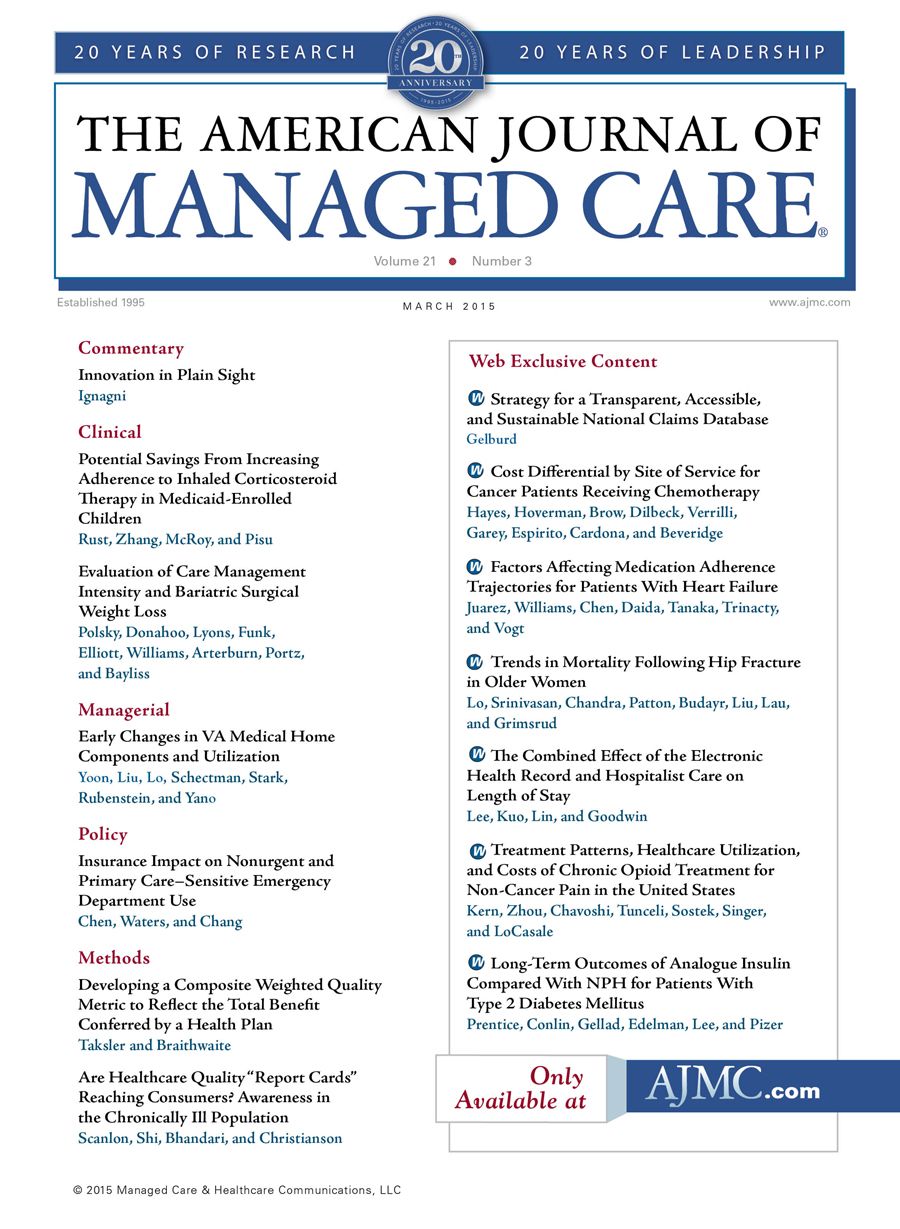- Center on Health Equity & Access
- Clinical
- Health Care Cost
- Health Care Delivery
- Insurance
- Policy
- Technology
- Value-Based Care
Innovation in Plain Sight
Innovations are powering the evolution of patient-centered care, and health plans are at the center of this innovation story.
This year marks the 20th anniversary of the debut of The American Journal of Managed Care (AJMC), and provides us with an opportunity to congratulate the team and reflect on what has happened over these 2 decades. When the Journal began, health insurers were implementing solutions to bring double-digit increases in healthcare costs down, and around AJMC's 10-year anniversary, the economic and social consequences of the large number of uninsured Americans took center stage.
As we look at the current landscape, the development of state-of-the-art tools for consumers and new benefit choices have been well-documented in these pages. These innovations are powering the evolution of patient-centered care, and health plans are at the heart of this innovation story.
Today, health plans are employing a multi-faceted approach to care coordination and disease management. With detailed data analysis, health plans are working with clinicians to identify gaps in care and to provide personalized support for patients managing chronic conditions. These efforts complement new benefit structures and payment arrangements that promote disease prevention and consistent monitoring so that patients receive the appropriate care at the right time. The results of these reforms are clear: better health outcomes for patients, more efficient care delivery, and improved value overall.
To sustain these value-based reforms, health plans are working with physicians, hospitals, consumers, and employers to align performance measurement across the public and private sectors. Most recently, our industry declared its support for the new value-based payment goals announced by the HHS. As a part of this effort, health plans will participate in learning collaboratives to work to share and advance these cutting-edge payment reforms, including medical homes, bundled payments, alternative quality contracts, and new risk-sharing mechanisms.
As these innovations evolve, health plans are also directly connecting with patients to make certain that they have the support, information, and decision-making tools they need to navigate the healthcare system. Our unique ability to help individuals across the care continuum—from the time patients make that first doctor's appointment to when they visit a specialist to help them to manage a chronic disease—is what enables health plans to ensure that patients receive the best value for their care. From cost calculators to 24/7 nurse hotlines, health plans are integrating new technology and partnering with digital experts to deliver personalized support that patients rely on when it comes to making their healthcare choices.
Research is demonstrating the effectiveness of these innovations while at the same time highlighting the many challenges facing consumers. In this new marketplace, individuals and families are looking for a wide range of choices when it comes to their health coverage so they can pick the policy that best meets their health and financial needs. However, regulators are now being asked to put the brakes on health plans’ benefit designs—specifically, the development of high-value networks. These tailored networks offer consumers access to high-quality providers and hospitals in addition to cost savings of 5% to 20% in the form of lower premiums.1 Yet, emerging policies at the state level directed at health plans’ provider networks would mandate that certain specialty hospitals and other providers participate in networks, irrespective of what price they charge to patients. Such requirements pose a serious threat to ongoing efforts to promote affordable value-based care.
Moreover, the adverse consequences of anticompetitive provider markets exacerbate the nation’s cost challenges. The impact of provider consolidation leaves many consumers and employers facing higher prices and increased costs without any indication of quality improvement; and individuals in highly concentrated markets are unfairly bearing the cost burden. In fact, a recent study in the Antitrust Health Care Chronicle2 was the first of its kind to measure the impact of hospital consolidation on premiums, and found that consumers living in the highly concentrated markets of northern California faced premiums that were 8% higher on average than those in southern California.
This monopolistic pricing challenge has become even more pronounced with prescription drug prices. In the last year alone, spending for prescription medications has increased by more than 12%—far outpacing healthcare prices across the board. Patients are experiencing take-it-or-leave-it pricing that jeopardizes access to the medications they need.
As we look toward the future, the focus of health plans will be to continue providing innovative solutions that promote affordability, access, and value for patients—that is our commitment to consumers, employers, and our public sector partners. This leadership should be documented in the pages of this journal, as will the policy debates ahead.Author Affiliation: America's Health Insurance Plans (AHIP), Washington, DC.
Source of Funding: None.
Author Disclosures: Ms Ignagni is employed by AHIP, the trade association representing health insurance plans. She reports no conflicts of interest.
Address correspondence to: Karen Ignagni, MBA, AHIP president, America's Health Insurance Plans, 601 Pennsylvania Ave NW, Washington, DC 20004. E-mail: AHIP@ahip.org.REFERENCES
1. O’Connor JT, Spector JM, High-value healthcare provider networks. Milliman Report. AHIP website. http://www.ahip.org/MillimanReportHPN2014/. Published July 2, 2014. Accessed March 11, 2015.
2. Thompson S. ACA exchange premiums and hospital concentration in California. Antitrust Health Care Chronicle. AHIP website. http://www.ahip.org/Issues/Documents/2015/Thompson-Article.aspx. Published January 2015. Accessed March 11, 2015.

Trends in Hospital Pricing for Vulnerable Emergency Department Users, 2021-2023
December 4th 2025Self-pay emergency department prices rose significantly from 2021 to 2023, especially at for-profit and system-affiliated hospitals, highlighting growing affordability challenges for uninsured and underinsured patients.
Read More
Integrated Care for Chronic Conditions: A Randomized Care Management Trial
December 3rd 2025The authors sought to understand the differential impact of payer-led community-based care management approaches on stakeholder-oriented outcomes for publicly insured adults with multiple chronic conditions.
Read More

